Mont Saint Michel is an abbey precariously perched on a rocky islet in a bay off northwestern France. This UNESCO World Heritage Site attracts tourists all year round for its magnificent architecture. Read this travel guide to know all the information needed for a hassle-free visit.
This rocky islet off the coast of France will take you back in time to the medieval days. The experience of walking along the narrow cobble-stoned alleyways to reach the Gothic styled abbey remains unchanged over the centuries. The stunning views of the abbey and its svelte spires rising 302 ft towards the heavens surrounded by reflective water lends a magical aura to this place.
This offshoot from the mainland is a commune with a population of just around 50 people. Among all the World Heritage Sites in France, Mont Saint Michel is one of the most famous, attracting 3.5 million visitors a year.
A lot of people confuse Mont Saint Michel to be a castle but it was a church when it was first built in the 8th century. It has withstood several threats and sieges, hosted monks and prisoners alike in its course of history.
During the 11th century, local historical events led to Mont Saint Michel being transformed into an abbey, a major pilgrimage site. During the Hundred Years’ War in the 15th century, the abbey became an impregnable military stronghold of the French against the English.
Later in the 18th century, this Benedictine abbey became a prison during the French Revolution which was finally shut down in 1863. Eventually, Mont Saint Michel was declared a historic monument in 1874 and became a UNESCO World Heritage Site in 1979.
Watch this beautifully captured video to appreciate the vast landscape and the mind-blowing architecture of Mont Saint Michel.
Where is Mont Saint Michel?
Mont Saint Michel is roughly 300 km (approximately 190 miles) from Paris in the north-western part of France. This place is located between Normandy and Brittany in the bay where River Couesnon ends its course into the sea.
This place makes for a good one-day trip from Paris. If you wish to stay overnight, it is best suggested to rest in Normandy as you have a lot of options.
When is the best time to visit Mont Saint Michel?
The weather in this part of the country is similar to Paris. It is slightly humid here since it is a beach destination. The best time to visit Mont Saint Michel is from March to October when the weather is at its best. July and August are the high seasons so crowds are at an all-time high. Low season is between November and February because the weather is frigid cold.
| Month | High / Low (°C) | High / Low (°F) |
| January | 3 / 9 | 37 / 48 |
| February | 4 / 10 | 39 / 50 |
| March | 5 / 12 | 41 / 54 |
| April | 6 / 13 | 43 / 55 |
| May | 8 / 16 | 46 / 61 |
| June | 10 / 18 | 50 / 64 |
| July | 12 / 20 | 54 / 68 |
| August | 13 / 21 | 55 / 70 |
| September | 11 / 19 | 52 / 66 |
| October | 9 / 16 | 48 / 61 |
| November | 5 / 12 | 41 / 54 |
| December | 4 / 10 | 39 / 50 |
Where to buy tickets to visit Mont Saint Michel?
Entry to Mont Saint Michel and to explore the island is free but access to the abbey is priced at €10. Follow the golden rule of buying tickets online to enter the abbey at Mont Saint Michel. You can purchase the tickets here. The abbey is open from morning 9 am to 7 pm in the evening.
How easy is it to reach the top of Mont Saint Michel?
For disabled visitors
- Restrooms for disabled people are located at the beginning of the main street called La Grande Rue, right after you cross the drawbridge.
- The shuttle bus drops all visitors at the entrance and there is no vehicle that is allowed inside the island
- Tourists in wheelchairs or canes can access the Grand Rue which is a cobble-stoned alleyway. Unfortunately, it is impossible to reach all the way to the top. The abbey is practically inaccessible since the route is steep and has large steps.
- For a complete guide on disabled people traveling to France, read this
For senior visitors
- The cobble-stoned pathway to reach all the way to the top is narrow and the climb is steep. There is no vehicle to ferry senior visitors or disabled tourists
- Unfortunately, there are hardly any benches along the way to sit and rest
For parents with kids
- If you have a baby in a pushchair, then it is not recommended to bring the pushchair owing to the terrain. The climb to the top to reach the abbey is steep with large stairs, so please carry a comfortable baby strap
- Try not to bring a pushchair to Mont Saint Michel as you cannot leave it in the luggage storage at the Tourist Information Centre due to security reasons
- Please be cautious of young kids as the ground here is uneven and almost vertical. Have an eye on them at all times
For visitors with pets
- You are free to carry your little dog in a pet carrier which is allowed on the shuttle bus but your dog is strictly not allowed inside the abbey
- Large dogs are not allowed in the shuttle buses (excluding guide or service dogs for disabled visitors)
- Instead keep your worries aside and leave your dog in a kennel at the Tourist Information Centre at a price of €8.10 inclusive of tax per day and per dog.
Travel tip for those who cannot climb Mont Saint Michel all the way to the top, it is best advised to marvel at the scenic landscape from the bridge. But then beware that the bridge is 2.5 km long and the shuttle bus doesn’t stop mid-way to drop, you might have to walk the bridge on your own from the shore.
*The prices mentioned are valid as of June 2018.

Tips for visitors before heading to Mont Saint Michel
- Wear comfortable walking shoes as there is a lot of walking and scaling of stairs involved
- Keep yourself well hydrated, do not forget to carry a bottle of water
- It is possible to visit Mont Saint Michel from Paris and return all in one-day if you plan your day well. If you start early from Paris then you can reach La Mont in 4 hours, explore the island for 6 hours, have lunch and head back the same day
- If you have time on your hands, then you can stay overnight in the seaside town of St. Malo or in the city of Rennes (in Brittany); in Caen or Bayeux (in Normandy).
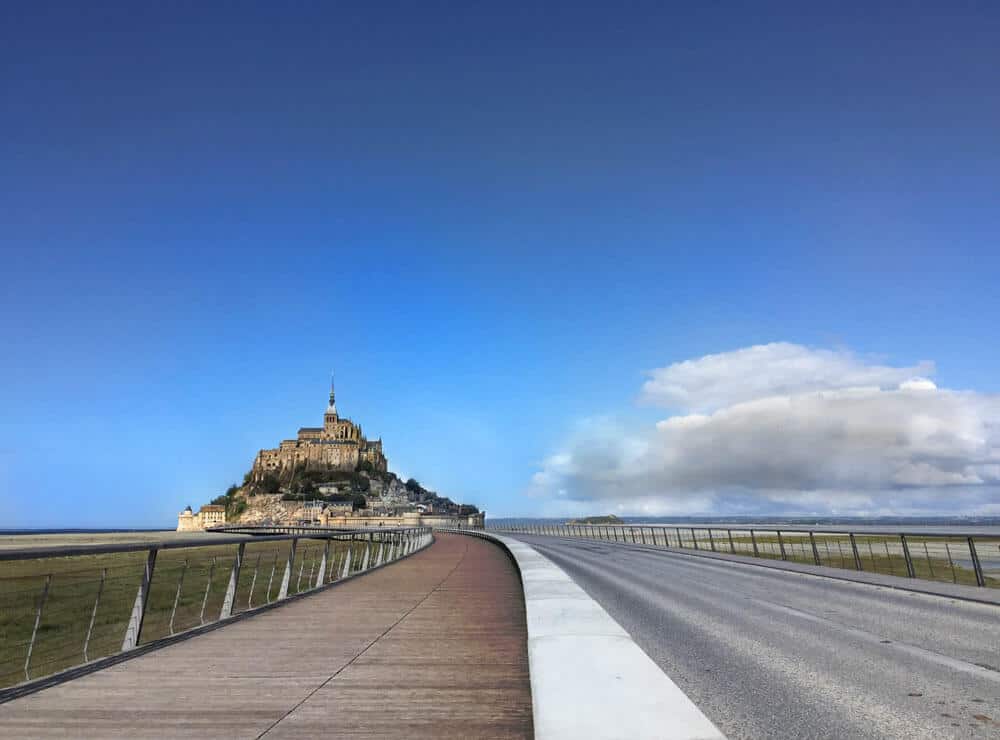
How to reach Mont Saint Michel?
By train
Option 1: Take the SNCF train from Paris Gare Montparnasse to Pontorson station near Mont Saint Michel. This round trip costs around €120 euros depending on the schedule. Check the GoEuro website for more details. You get great discounts on TrainLine if you book in advance.*
This train journey is 3 hours long one way with one or two transits in between. Once you alight from the train in Pontorson, right outside the train station you will find a bus station to go to Mont Saint Michel.
This bus journey is for 30 minutes and costs €3 one way.
Option 2: Take the SNCF train from Paris Gare Montparnasse to Rennes which is a direct train. This round trip costs around €100 euros depending on the schedule on the GoEuro website. You get great discounts on TrainLine website if you book in advance.*
From Renne, take a bus run by the company Keolis to Mont Saint Michel, the journey is 1.5 hours along and costs €15 one way. There is 25% discount for travelers under 26 and over 60.
It is easy to find the Keolis buses outside the Renne train station. These buses are blue and white in color. You can buy the ticket from the driver himself at the beginning of your journey.
By bus
You can take a bus from Paris Quai de Bercy bus station. These buses ply directly to Mont Saint Michel. This journey is 5.5 hours long and costs around €80 one way. You can book the tickets on GoEuro. You can get good discounts on OuiBus website if you book in advance.*
By car
Option 1: It is definitely alluring to drive from Paris to Mont Saint Michel. While the thought is fun to execute, please beware of the traffic that you might encounter in the interiors of Paris until you hit the highway towards La Mont.
There are a lot of car rentals in Paris, the popular ones being Europcar or Hertz to name a few. Please book the car online in advance. You will need to pay an initial sum when you book the car. The price depends on the car you are renting. Pick and drop the car from the Charles de Gaulle Airport or from Montparnasse for an easy exit from the city to join A13 highway. The average cost of booking a car for a full-day drive depends on the distance driven.
Distance and time taken to reach La Mont:
Paris – 360 km / 4h00 (via Caen)
Paris – 380 km / 4h30 (via Le Mans)
Option 2: Another viable and recommended option is to take a train to Rennes or Caen from Paris and rent a car from these places to go to Mont Saint Michel. This is cost effective and also the drive is more fun on the A84 (exit 33) highway.
Distance and time taken to reach La Mont:
Rennes: – 70 km / 1h20
Caen – 130 km / 1h30
Car parking charges are slightly expensive. The tariffs are as follows:
Duration <30 minutes – free
Duration < 2 hours – €6.30 Duration >24 hours to <48 hours – €23.40 hours
How to reach Mont Saint Michel from the bus station?
- There is a free bus shuttle service called ‘Passeur’ line which plies from the shuttle hub, located next to the Tourist Information Centre next to the car park.
- It takes about 12 minutes for the shuttle to drive from the hub to the end stop, located 350 meters away from the city walls.
- The Passeur will take you to the Mont-Saint-Michel end stop, located 350 meters away from the city walls. It runs non-stop from 7.30am to 12.00am.
- For a unique experience, you can take a horse-drawn carriage called ‘Maringote’ line. A one-way journey costs €5.30.
What to do inside the city walls of Mont Saint Michel?
There are two gates into the walled city. The Porte de l’Avancée, the main gate at the end of the bridge, leads straight to the Grande Rue. La Grande Rue is a crowded narrow street with a lot of cafes and souvenir shops bustling with visitors. This street leads you up to the abbey.
The second gate is the lesser-used Porte Échauguette, to the left of the main gate. It is the quietest route up. For rewarding vistas of the coast, head up the Porte Échauguette. Make sure to head to the Terrasse de l’Ouest, which offers a stunning panorama over the bay.
What to eat at Mont Saint Michel?
Restaurants on the island are expensive. If you are a budget traveler, it is suggested that you eat on the mainland at affordable rates.* Here are a few suggestions for famous eateries on La Mont:
- Le Mouton Blanc – This award-winning restaurant serves mouthwatering lamb dishes like roast lamb casserole and rack of lamb
- La Sirène – is a creperie which is an awesome breakfast place. There are pancakes, ham, salmon, egg, or vegetables. The sweet crêpes are accompanied with your choice of fruit, chocolate, nuts, cream, or caramel. Also, there is coffee, wine, and Normandy cider
- Auberge Saint-Pierre – Serves Italian cuisine and seafood dishes. The outside terrace provides stunning views of the bay
- Du Guesclin – Three set menus are provided to suit a variety of tastes and budgets
- La Mère Poulard – One of the oldest restaurants running since the 19th century has hosted a lot of celebrities here. They are famous for their fluffy omelets which are very expensive, costing more than €20
- La Cloche – This is another famous creperie serving very tasty crepes
- When you are on the island on the mainland, do not forget to devour the richly-flavored lamb meat called agneau de pré-salé or ‘salt meadow lamb’
Guided tours to Mont Saint Michel
There are some amazing guided tours to Mont Saint Michel from Paris which includes pick up and drop, a guided tour and lunch at Mont Saint Michel.*
Things to do apart from visiting Mont Saint Michel
There are many things to see and do including museums and churches like La Chapelle-Saint-Aubert.
On the Grande Rue on the way up to the abbey, keep an eye out for the parish church of Saint-Pierre, surrounded by a cemetery and housing a silver statue dedicated to Saint-Michel.
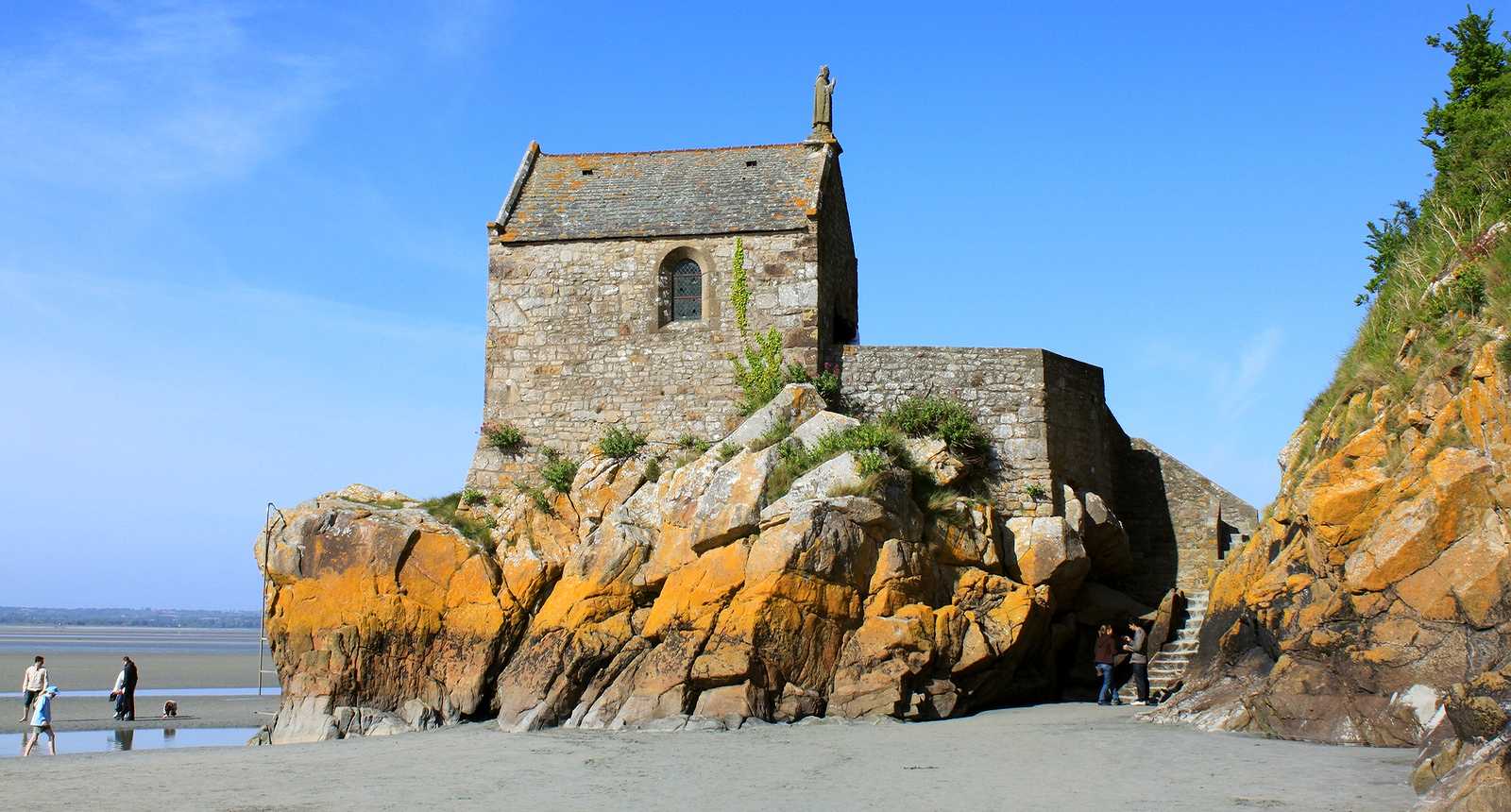
Pic courtesy: Tourisme en France
There’s also the Maritime Museum, which offers insight into the surrounding environment of the island and its ecology.
There are interesting events organized at Mont Saint Michel on special occasions. You can participate in the Marathon organized in the month of May every year.
There is a Christian Art Festival which is free for all the visitors with shows and concerts scheduled for the whole weekend. You need to be on the lookout for schedules.
Mont Saint Michel is at its glittery best during Christmas when the whole island is lit up and there are Christmas trees on the streets and the ramparts are decorated. Nearly seven kilometers of light bulbs are strung along the island’s walls.
Mont Saint Michel is a monument that has caught the fascination of many travelers around the world for its uncanny looks. No other landscape has the distinct feature of rapidly changing tides around it which dictates the way travelers visit a place. As if the views from the top of the island wasn’t enough, the features of the monument slowly appearing from the horizon as you approach it makes for a jaw-dropping experience. It is loaded with history and quirky tales from the recent past alike. Hiring a guide will do a great justice as every aspect of the monument will be uncovered to you in great detail.
Why was Mont Saint Michel built?
Mont Saint Michel Abbey has a history of 1,300 years starting from the 8th century. Previously this place was known as Mont Tombe. Legend has it that archangel Saint Michel began to appear to the Bishop of Avranches, St. Aubert’s demanding the construction of a church on this rocky islet.
St. Aubert disregarded the visions he was having until Saint Michel placed his flaming finger on the forehead of St. Aubert. The skull of St. Aubert with this perforation can be seen at Saint-Gervais Basilica in Avranches. It was then that the construction of the church began in the year 708.
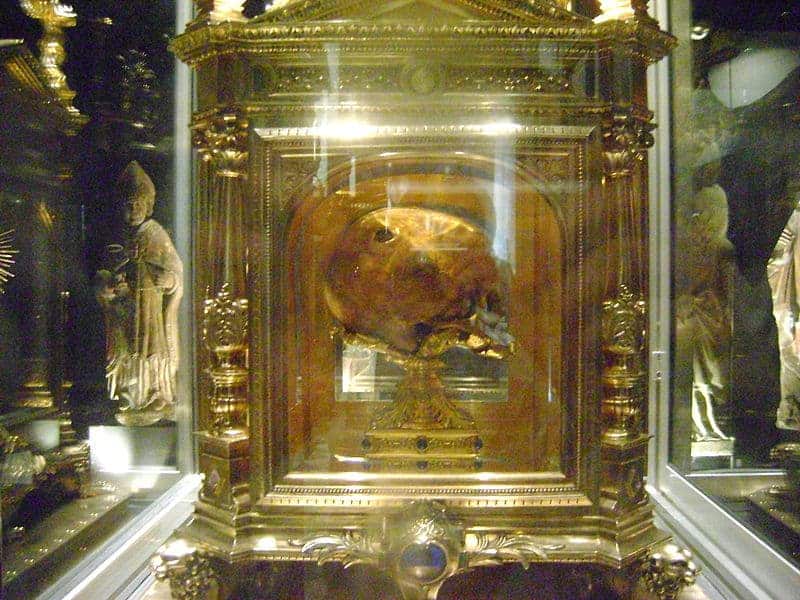
History of Mont Saint Michel
Two centuries later in 933, the Duke of Normandy gifted the site to the Benedictine monks, who began building an ambitious abbey church under the patronage of William the Conqueror. The abbey became a major pilgrimage destination in the Middle Ages.
During the Hundred Years’ War, the Kingdom of England repeatedly launched assaults many times between 1423- 1434 on this site but were unable to seize Mont Saint Michel to bring it under their control. It was during this time that the church evolved into a military citadel – an impregnable fortress in the sea—the only spot in Normandy that never fell to the English owing to the abbey’s strong fortification.

With the French Revolution in the 18th century, the Abbey of Mont Saint Michel was closed and it was turned into a prison. The prison was shut down in 1863 and eventually, Mont Saint Michel was declared a historic monument in 1874 and became a UNESCO World Heritage Site in 1979.
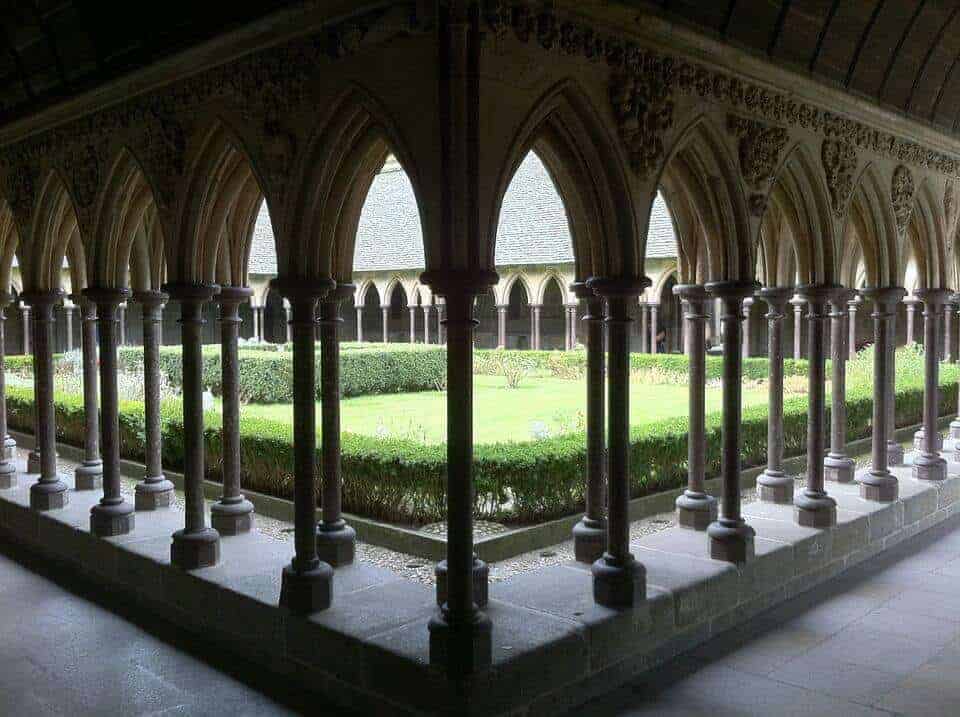
The story of the tides around Mont Saint Michel
Mont Saint Michel stands smugly in the bay where River Couesnon ends its journey into the sea. This region is famous for sudden changes in tidal levels and this has shaped the landscape of this place over the years due to the deposit of sediments brought in by the tides.
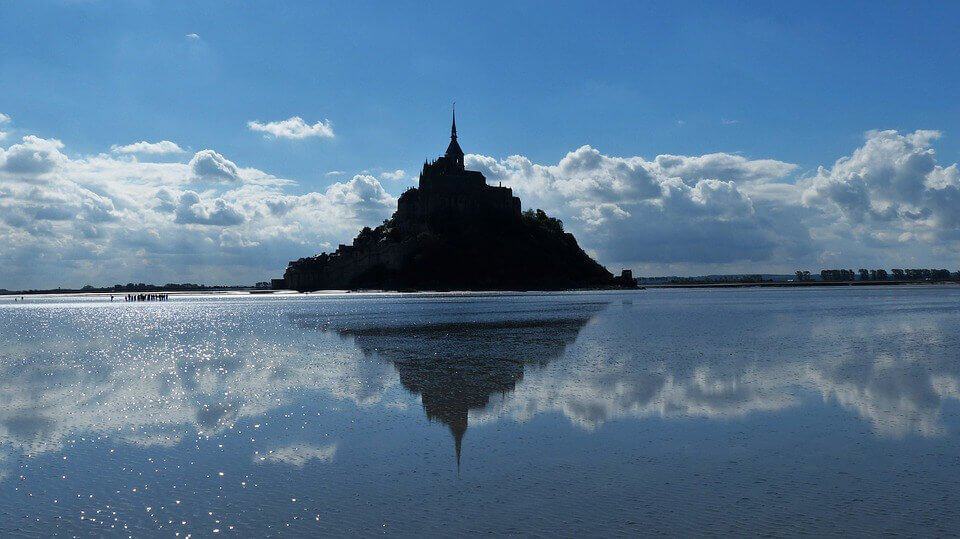
The distance between the shore of the mainland and the island is approximately 2 km today whereas the distance between them centuries ago was a whopping 7 km. The highest tide can rise up to 45 feet and sweep in at some 200 feet per minute.
The tides bring fertile soil to the shore and these sediments are perfect for the growth of grass. Incidentally, the people of Normandy gradually started irrigating this stretch to reclaim land, pushing out the edge of the shore and bringing more of the land by the sea under cultivation. This salty grass that grows on the sandy ground makes for excellent grazing. The sheep reared in this area has a unique and mouthwatering taste when cooked. A very famous lamb dish from this meat is served in restaurants here.
The tides today
It was estimated that if the sediments are allowed to build up then by the year 2040, the island would be part of the mainland itself. To prevent this, the task of building a dam was taken up to ensure that all the water that comes from the tides slowly flows back into the bay. The cost of the project was $300 million with two objectives. One was to build a bridge to access the island from the mainland. The second one was to build a dam on the Couesnon River to hold the water during high tide and then release it when the tide recedes.
This dam opens up to let the seawater enter at high tide and then releases it again at low tide in order to push water and sand out, relieving the buildup of silt around La Mont. Though there is an honest effort through this dam to maintain the maritime character of this place, nature seems to be slowly creeping in with its tides and the sediments. It is a true testament that nature always has its way no matter how hard humans try to negate it.
Interesting facts of Mont Saint Michel
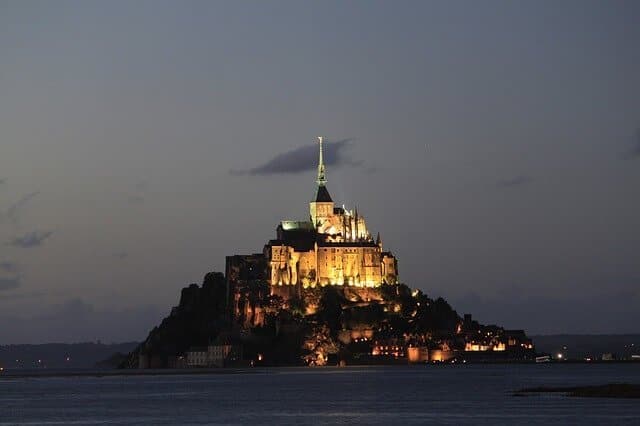
- Mont Saint Michel is a commune with only 50 people residing in this island. During the mid-19th century, the island hosted more than a 1,000 people but today as per census records from 2015, there are only 50 people.
- When the prison at Mont Saint Michel was finally closed in 1863, ironically there were a lot of protests due to the closure of the prison from the merchants who resided there. These merchants had thriving businesses at Mont Saint Michel providing food and lodgings for the family members of the prisoners.
- Right below the choir, three floors beneath you is a cellar which has a massive wooden wheel. This wooden wheel was turned by prisoners like guinea pigs to haul goods up to the abbey. And before the prisoners came, the stones and construction material were brought here by boats from the mainland and drawn by rope to the top.
- There is a statue of St. Michael, the archangel atop the spire some 300 feet in the air, his sword held aloft and his heel crushing a dragon, representing Satan or sin.
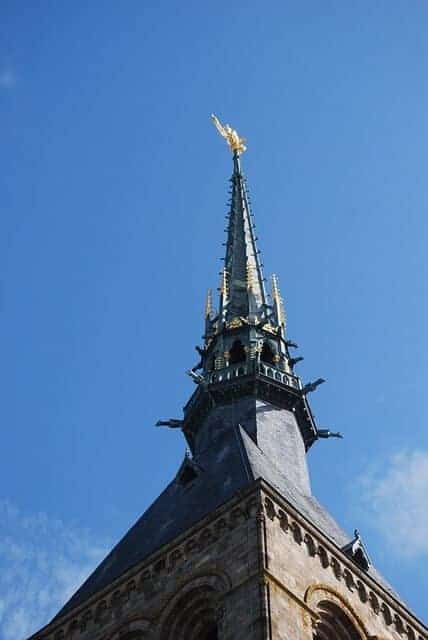
- Sometime during the 15th century, part of the church came crashing down. The new choir that was built in the church harmoniously blends into the structure that did not crash. This subtle difference in architecture and the difference between the old and the new is easy to miss but if you pay attention to the interiors of the abbey, you will notice this architectural marvel.
Interesting facts about the construction of Mont Saint-Michel
- The placing of the church, the monastery and other buildings on this island follows a structural hierarchy of feudal society. On top of the spire is the statue of St. Michael representing God, then there is the abbey and monastery. Below this is the Great halls, then stores and housing. At the bottom and outside the walls are the fishermen and farmers’ housing.
- This region experiences very powerful tides and tourists should be precautious to not walk to the islet by foot when the water has receded or during high tides. The water levels change within fractions and there are high chances of getting stranded in mudflats which act like quicksand.
- The threat of drowning in the water during high tide is real even during the Middle Ages, so much so that pilgrims who planned to go to Mont Saint Michel would draft a will because they were not sure that they would return.
- In the Bayeux Tapestry (an embroidered cloth depicting the Norman conquest of England) from the 15th century shows two Norman knights being rescued from the quicksand in the tidal flats during a battle here.
- There are times when tourists are stranded on the islet when the tides increase all of a sudden where even the bridge gets submerged. The tourists are allowed to leave only when the water recedes, the bridge is clear of water and it is safe to return to the mainland. There are instances in the course of history since the 8th century of people losing their lives when they were trying to cross the tides to reach the island.
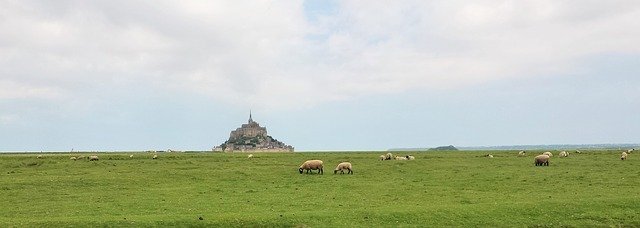
We hope that you enjoyed reading our detailed guide to visit Mont Saint Michel.
We have shared all the relevant information needed to visit this heritage site. As suggested, book your entry tickets online in advance to enjoy a hassle-free experience.
Do write to us, in case you have any questions and we at TalkTravel App are happy to help. If you need any help in building a travel itinerary or you have any other query, download our free TalkTravel App. It is available for download on your Android or iOS device. You can download the TalkTravel App for free and reach out to the local expert without any additional cost. You are free to ask any doubt before or during your travel and our local expert will be ready to assist you.
We wish you a safe and happy travel!
Are you traveling around France? You might want to look at the other guides and posts we have written for France, to make your travel more easy and enjoyable.
*We do not promote any brands or businesses on our platform. We only suggest experiences which are popular keeping in mind the best intentions of our travelers. We at Talk Travel are not responsible for any untoward incident during your travel with any of the services recommended in this article.


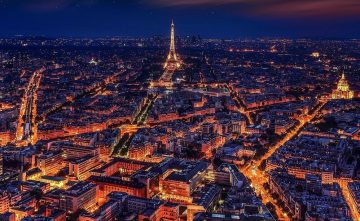

Pingback: day trips from Paris
Pingback: Paris itinerary to help you plan your holiday - Talk Travel